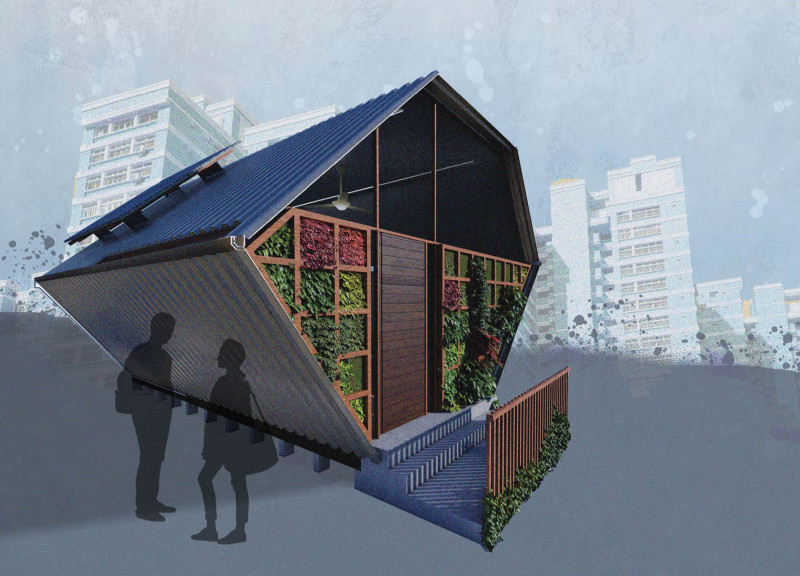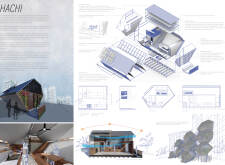5 key facts about this project
At its core, the Hachi project aims to redefine residential living by addressing both individual and communal needs. The design integrates seamlessly with its surroundings while creating spaces that encourage social interaction and collaboration among residents. This dual approach embodies the essence of urban living in a high-density environment, promoting a sense of belonging and community.
The architectural design features a two-story structure characterized by a unique geometric form that departs from conventional residential layouts. This choice not only contributes to the visual appeal of the project but also serves functional purposes, allowing for natural light and ventilation throughout the living spaces. The interior layout is meticulously crafted to ensure fluidity between different areas, such as the kitchen, dining, and living rooms, facilitating everyday interactions.
Materiality plays a significant role in the Hachi project, reflecting a strong commitment to sustainability. By using recycled metals sourced from shipping containers, the design effectively incorporates robust materials that offer both durability and an industrial aesthetic. The inclusion of polycarbonate windows further enhances energy efficiency, allowing ample natural light while maintaining insulation. Additionally, elements like recycled pallet wood are employed to provide warmth and texture within the home, demonstrating a conscious choice to utilize sustainable resources.
One of the project’s notable features is its approach to environmental impact. The integration of solar panels signifies a dedication to renewable energy, while rockwool insulation ensures a comfortable living environment throughout various weather conditions. Water management is another critical aspect, with rainwater harvesting systems incorporated into the design, emphasizing responsible resource usage and enhancing the sustainability of the overall development.
The Hachi project showcases a unique understanding of the importance of community within residential architecture. The inclusion of collaborative spaces fosters social interaction, contributing to a strong sense of community among residents. These designed areas can serve multiple purposes, allowing for gatherings and shared activities that encourage a neighborhood atmosphere. This focus on shared experiences highlights the project’s intention to create lasting relationships among its inhabitants.
Furthermore, the concept of vertical farming embedded within the design reflects a modern approach to urban living. By incorporating green elements into residential settings, the project not only promotes self-sufficiency but also enhances the overall quality of life for its residents. This integration of nature within the architectural framework is particularly relevant in urban contexts, where access to green spaces is often limited.
The Hachi project stands as an exemplary model of how architecture can effectively respond to contemporary challenges faced in urban environments. Its innovative design successfully balances individual needs with community values, all while prioritizing sustainable practices. Those interested in delving deeper into the architectural plans, sections, and design ideas of the Hachi project are encouraged to explore the detailed presentation available. This exploration will provide further insights into the thoughtful design strategies and materials used, contributing to a comprehensive understanding of this noteworthy architectural endeavor.























